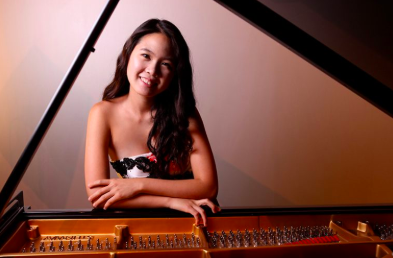Chaeyoung Park, piano
Weill Recital Hall at Carnegie Hall, New York, NY
October 27, 2019
A day of heavy windswept rain gave way to a lovely sunset, which seemed a symbol for the impressive, successful award recital by Chaeyoung Park, the latest first prize winner of the prestigious Hilton Head International Piano Competition. Only 22, Ms. Park (currently a Juilliard student) has already had numerous successes in the important competition scene, and appears regularly with orchestra and in chamber music.
Ms. Park’s program was thoughtful, focusing on rarely heard items—not the standard “debut” fare. The second half provided one repertory staple, to be discussed below. Her strengths, as shown on Sunday night, are: a refined ear for piano color, excellent use of pedaling to create sophisticated mixes of sound, total concentration, rock-steady technical means, and not a single note played without thought and feeling, while remaining spontaneous.
She opened with four pieces from Gyögy Ligeti’s Musica ricercata (1951/53, premiered 1969), that systematic exploration (ricercare: seeking) of every possibility for a work based on just one note (until the end), then two, then three, etc., until the eleventh piece gives us all twelve notes. It was banned from performance by the Soviets in the 1950s as too radical. Ms. Park chose two lively and two introspective pieces from the set, including the mournful memorial to Ligeti’s fellow countryman Béla Bartók, which connected nicely with the final work on the first half (see below). Her rendering of the fourth piece, a limping waltz “on a barrel organ” even seemed to relate to the Ravel that followed. In these brief but accessible works, Park immediately displayed her great personality, a characteristic that defined the whole night.
Following that, Ravel’s Valses nobles et sentimentales (1911), a set of seven waltzes plus a nostalgic epilogue, was given a bold reading whose only fault was excessive rubato. This work, which meant a great deal to Ravel personally, has a score that abounds in descriptive terms such as avec une expression intense, très expressif, and even the dreaded word rubato. The trick is, however, to apply these nuances in two ways: 1) Only where indicated, and 2) Minimally. Henriette Faure, a pianist who was the first ever to present Ravel’s complete piano music in Paris in the early 1920s, and who was coached by the composer, relates what a “frightful burden” it was to work on these waltzes in particular with Ravel, that he was a “human metronome.” For some reason, Ms. Park omitted the obligatory repeat of the second section of waltz no. 4. Nevertheless, Ms. Park’s conviction carried the work. The seventh waltz, which Ravel regarded as the most characteristically Viennese, and the Epilogue were both ravishing.
The first half concluded with Bartók’s suite Out of Doors (1926), which Ms. Park admirably describes as “a recreation of the natural world, raw and undecorated.” Her ability to create sonic atmosphere at the keyboard was fully realized here, especially in the haunting evocation of nighttime in the fourth movement. She had the knack of organizing all of Bartók’s material into compelling emotion-containing phrases and groups. The score makes fierce demands dynamically, and I urge Ms. Park to consult the many recordings that the composer, a virtuoso pianist, made of his own works. Even when fortissimo is called for, he never sounds percussive. Some of her big dynamics were overplayed, though they were always part of her complete emotional commitment. This is not a “careful” competition winner, and Hilton Head is to be commended for consistently choosing such fine musicians.
After intermission came Brahms’ monumental Piano Sonata No. 3 in F minor, Op. 5. This five-movement work strains at the boundaries of what a lone piano/pianist can do, so symphonic are its textures. Here, all of Ms. Park’s strengths were audible, especially a wonderful feeling for expansion, a stretching of the line for emotional heightening, and a mature ability to take her time. The slow movement is prefaced by several lines of romantic poetry that speak of “two hearts united in love,” and the entire sonata seems to speak of the many dimensions of that relation, including its demise. Perhaps for endurance’s sake, Ms. Park omitted the exposition repeat in the first movement, which “Brahms the classicist” would not have liked; though she did do the slow movement’s repeat of its first theme. Ms. Park was at her very best in the introspective “as softly and tenderly as possible” moments of the work, and the Intermezzo, subtitled a Rückblick (a look back), even showed Brahms as a proto-Impressionist. Ms. Park’s virtuosity was exciting as the fifth movement whirled to its huge close.
After a well-deserved standing ovation, Ms. Park favored the audience with a sweet encore by Gershwin/Wild: “Embraceable You,” which was played with exquisite voicing, subtlety, and an elegance that Earl Wild would surely have enjoyed.

